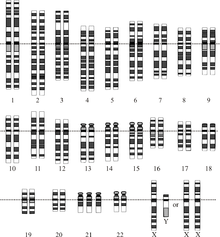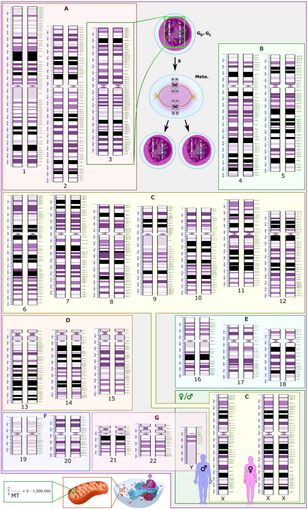Chromosome abnormality
Achromosomal abnormality,chromosomal anomaly,chromosomal aberration,chromosomal mutation,orchromosomal disorderis a missing, extra, or irregular portion ofchromosomalDNA.[1][2]These can occur in the form of numerical abnormalities, where there is an atypical number of chromosomes, or as structural abnormalities, where one or more individual chromosomes are altered.Chromosome mutationwas formerly used in a strict sense to mean a change in a chromosomal segment, involving more than onegene.[3]Chromosome anomalies usually occur when there is an error incell divisionfollowingmeiosisormitosis.Chromosome abnormalities may be detected or confirmed by comparing an individual'skaryotype,or full set of chromosomes, to a typical karyotype for thespeciesviagenetic testing.
Sometimes chromosomal abnormalities arise in the early stages of anembryo,sperm,orinfant.[4]A mother's age is one of the many environmental factors that might lead to genetic abnormalities. The implications of chromosomal abnormalities depend on the specific problem, they may have quite different ramifications. Some examples areDown syndromeandTurner syndrome.
Numerical abnormality[edit]

An abnormal number of chromosomes is known asaneuploidy,and occurs when an individual is either missing a chromosome from a pair (resulting inmonosomy) or has more than two chromosomes of a pair (trisomy,tetrasomy,etc.).[5][6]Aneuploidy can be full, involving a whole chromosome missing or added, or partial, where only part of a chromosome is missing or added.[5]Aneuploidy can occur withsex chromosomesorautosomes.[citation needed]
Rather than having monosomy, or only one copy, the majority of aneuploid people have trisomy, or three copies of one chromosome.[citation needed]An example of trisomy in humans isDown syndrome,which is a developmental disorder caused by an extra copy of chromosome 21; the disorder is therefore also called trisomy 21.[7]
An example of monosomy in humans isTurner syndrome,where the individual is born with only one sex chromosome, an X.[8]
Sperm aneuploidy[edit]
Exposure of males to certain lifestyle, environmental and/or occupational hazards may increase the risk ofaneuploidspermatozoa.[9]In particular, risk of aneuploidy is increased bytobacco smoking,[10][11]and occupational exposure tobenzene,[12]insecticides,[13][14]andperfluorinated compounds.[15]Increased aneuploidy is often associated with increased DNA damage in spermatozoa.
Structural abnormalities[edit]


When the chromosome's structure is altered, this can take several forms:[16]
- Deletions:A portion of the chromosome is missing or has been deleted. Known disorders in humans includeWolf–Hirschhorn syndrome,which is caused by partial deletion of the short arm of chromosome 4; andJacobsen syndrome,also called the terminal 11q deletion disorder.
- Duplications:A portion of the chromosome has been duplicated, resulting in extra genetic material. Known human disorders includeCharcot–Marie–Tooth disease type 1A,which may be caused by duplication of the gene encodingperipheral myelin protein 22(PMP22) on chromosome 17.
- Inversions:A portion of the chromosome has broken off, turned upside down, and reattached, therefore the genetic material is inverted.
- Insertions:A portion of one chromosome has been deleted from its normal place and inserted into another chromosome.
- Translocations:A portion of one chromosome has been transferred to another chromosome. There are two main types of translocations:
- Reciprocal translocation:Segments from two different chromosomes have been exchanged.
- Robertsonian translocation:An entire chromosome has attached to another at thecentromere- in humans, these only occur with chromosomes 13, 14, 15, 21, and 22.
- Rings:A portion of a chromosome has broken off and formed a circle or ring. This happens with or without the loss of genetic material.
- Isochromosome:Formed by the mirror image copy of a chromosome segment including the centromere.
Chromosome instability syndromesare a group of disorders characterized by chromosomal instability and breakage. They often lead to an increased tendency to develop certain types of malignancies.
Inheritance[edit]
Most chromosome abnormalities occur as an accident in the egg cell or sperm, and therefore the anomaly is present in every cell of the body. Some anomalies, however, can happen after conception, resulting inMosaicism(where some cells have the anomaly and some do not). Chromosome anomalies can be inherited from a parent or be "de novo".This is why chromosome studies are often performed on parents when a child is found to have an anomaly. If the parents do not possess the abnormality it was not initiallyinherited;however, it may be transmitted to subsequent generations.[citation needed]
Acquired chromosome abnormalities[edit]
Most cancers, if not all, could cause chromosome abnormalities,[17]with either the formation of hybrid genes and fusion proteins, deregulation of genes and overexpression of proteins, or loss of tumor suppressor genes (see the "Mitelman Database"[18]and theAtlas of Genetics and Cytogenetics in Oncology and Haematology,[19]). Furthermore, certain consistent chromosomal abnormalities can turn normal cells into a leukemic cell such as the translocation of a gene, resulting in its inappropriate expression.[20]
DNA damage during spermatogenesis[edit]
During themitoticandmeioticcell divisions of mammaliangametogenesis,DNA repairis effective at removingDNA damages.[21]However, inspermatogenesisthe ability to repair DNA damages decreases substantially in the latter part of the process as haploidspermatidsundergo major nuclearchromatinremodeling into highly compactedspermnuclei. As reviewed by Marchetti et al.,[22]the last few weeks of sperm development beforefertilizationare highly susceptible to the accumulation of sperm DNA damage. Such sperm DNA damage can be transmitted unrepaired into the egg where it is subject to removal by the maternal repair machinery. However, errors in maternal DNA repair of sperm DNA damage can result inzygoteswith chromosomal structural aberrations.[citation needed]
Melphalanis a bifunctionalalkylating agentfrequently used inchemotherapy.Meiotic inter-strand DNA damages caused by melphalan can escape paternal repair and cause chromosomal aberrations in the zygote by maternal misrepair.[22]Thus both pre- and post-fertilization DNA repair appear to be important in avoiding chromosome abnormalities and assuring thegenomeintegrity of theconceptus.[citation needed]
Detection[edit]
Depending on the information one wants to obtain, different techniques and samples are needed.[citation needed]
- For theprenatal diagnosisof a fetus,amniocentesis,chorionic villus samplingor circulating foetal cells would be collected and analysed in order to detect possible chromosomal abnormalities.
- For thepreimplantational diagnosisof an embryo, ablastocyst biopsywould be performed.
- For a lymphoma or leukemia screening the technique used would be abone marrow biopsy.
Nomenclature[edit]
-
Three chromosomal abnormalities with ISCN nomenclature, with increasing complexity:(A)A tumour karyotype in a male with loss of the Y chromosome,(B)Prader–Willi Syndrome i.e. deletion in the 15q11-q12 region and(C)an arbitrary karyotype that involves a variety of autosomal and allosomal abnormalities.[23]
-
Humankaryotypewith annotatedbands and sub-bandsas used for the nomenclature of chromosome abnormalities. It shows dark and white regions as seen onG banding.Each row is vertically aligned atcentromerelevel. It shows 22homologousautosomalchromosome pairs, both the female (XX) and male (XY) versions of the twosex chromosomes,as well as themitochondrial genome(at bottom left).
TheInternational System for Human Cytogenomic Nomenclature(ISCN) is an international standard forhuman chromosomenomenclature,which includes band names, symbols and abbreviated terms used in the description of human chromosome and chromosome abnormalities. Abbreviations include a minus sign (-) for chromosome deletions, anddelfor deletions of parts of a chromosome.[24]
See also[edit]
- Aneuploidy
- Chromosome segregation
- Genetic disorder
- Gene therapy
- Nondisjunction
- Obstetrical complications
References[edit]
- ^"Chromosomal Abnormalities",Understanding Genetics: A New York, Mid-Atlantic Guide for Patients and Health Professionals,Genetic Alliance, 2009-07-08,retrieved2023-09-27
- ^NHGRI. 2006.Chromosome AbnormalitiesArchived2006-09-25 at theWayback Machine
- ^Rieger, R., Michaelis, A., Green, M.M. (1968)."Mutation".A glossary of genetics and cytogenetics: Classical and molecular.New York: Springer-Verlag.ISBN978-0-387-07668-3.
- ^Chen H (2006).Atlas of genetic diagnosis and counseling.Totowa, N.J: Humana Press.ISBN978-1-58829-681-8.
- ^abGardner, R. J. M. (2012).Chromosome abnormalities and genetic counseling.Sutherland, Grant R., Shaffer, Lisa G. (4th ed.). Oxford: Oxford University Press.ISBN978-0-19-974915-7.OCLC769344040.
- ^"Numerical Abnormalities: Overview of Trisomies and Monosomies - Health Encyclopedia - University of Rochester Medical Center".urmc.rochester.edu.Retrieved2020-11-17.[failed verification]
- ^Patterson D (2009-07-01). "Molecular genetic analysis of Down syndrome".Human Genetics.126(1): 195–214.doi:10.1007/s00439-009-0696-8.ISSN1432-1203.PMID19526251.S2CID10403507.
- ^"Turner Syndrome".National Institute of Child Health and Human Development.Retrieved2020-11-17.
- ^Templado C, Uroz L, Estop A (2013). "New insights on the origin and relevance of aneuploidy in human spermatozoa".Mol. Hum. Reprod.19(10): 634–43.doi:10.1093/molehr/gat039.PMID23720770.
- ^Shi Q, Ko E, Barclay L, Hoang T, Rademaker A, Martin R (2001). "Cigarette smoking and aneuploidy in human sperm".Mol. Reprod. Dev.59(4): 417–21.doi:10.1002/mrd.1048.PMID11468778.S2CID35230655.
- ^Rubes J, Lowe X, Moore D, Perreault S, Slott V, Evenson D, Selevan SG, Wyrobek AJ (1998)."Smoking cigarettes is associated with increased sperm disomy in teenage men".Fertil. Steril.70(4): 715–23.doi:10.1016/S0015-0282(98)00261-1.PMID9797104.
- ^Xing C, Marchetti F, Li G, Weldon RH, Kurtovich E, Young S, Schmid TE, Zhang L, Rappaport S, Waidyanatha S, Wyrobek AJ, Eskenazi B (2010)."Benzene exposure near the U.S. permissible limit is associated with sperm aneuploidy".Environ. Health Perspect.118(6): 833–9.doi:10.1289/ehp.0901531.PMC2898861.PMID20418200.
- ^Xia Y, Bian Q, Xu L, Cheng S, Song L, Liu J, Wu W, Wang S, Wang X (2004). "Genotoxic effects on human spermatozoa among pesticide factory workers exposed to fenvalerate".Toxicology.203(1–3): 49–60.doi:10.1016/j.tox.2004.05.018.PMID15363581.S2CID36073841.
- ^Xia Y, Cheng S, Bian Q, Xu L, Collins MD, Chang HC, Song L, Liu J, Wang S, Wang X (2005)."Genotoxic effects on spermatozoa of carbaryl-exposed workers".Toxicol. Sci.85(1): 615–23.doi:10.1093/toxsci/kfi066.PMID15615886.
- ^Governini L, Guerranti C, De Leo V, Boschi L, Luddi A, Gori M, Orvieto R, Piomboni P (2014)."Chromosomal aneuploidies and DNA fragmentation of human spermatozoa from patients exposed to perfluorinated compounds".Andrologia.47(9): 1012–9.doi:10.1111/and.12371.hdl:11365/982323.PMID25382683.S2CID13484513.
- ^"Chromosome Abnormalities".atlasgeneticsoncology.org.Archivedfrom the original on 14 August 2006.Retrieved9 May2018.
- ^"Chromosomes, Leukemias, Solid Tumors, Hereditary Cancers".atlasgeneticsoncology.org.Archivedfrom the original on 28 January 2015.Retrieved9 May2018.
- ^"Mitelman Database of Chromosome Aberrations and Gene Fusions in Cancer".Archivedfrom the original on 2016-05-29.
- ^"Atlas of Genetics and Cytogenetics in Oncology and Haematology".atlasgeneticsoncology.org.Archivedfrom the original on 2011-02-23.
- ^Chaganti RS, Nanjangud G, Schmidt H, Teruya-Feldstein J (October 2000). "Recurring chromosomal abnormalities in non-Hodgkin's lymphoma: biologic and clinical significance".Seminars in Hematology.37(4): 396–411.doi:10.1016/s0037-1963(00)90019-2.ISSN0037-1963.PMID11071361.
- ^Baarends WM, van der Laan R, Grootegoed JA (2001)."DNA repair mechanisms and gametogenesis".Reproduction.121(1): 31–9.doi:10.1530/reprod/121.1.31.hdl:1765/9599.PMID11226027.
- ^abMarchetti F, Bishop J, Gingerich J, Wyrobek AJ (2015)."Meiotic interstrand DNA damage escapes paternal repair and causes chromosomal aberrations in the zygote by maternal misrepair".Sci Rep.5:7689.Bibcode:2015NatSR...5E7689M.doi:10.1038/srep07689.PMC4286742.PMID25567288.
- ^Warrender JD, Moorman AV, Lord P (2019)."A fully computational and reasonable representation for karyotypes".Bioinformatics.35(24): 5264–5270.doi:10.1093/bioinformatics/btz440.PMC6954653.PMID31228194.
- "This is an Open Access article distributed under the terms of the Creative Commons Attribution License (http://creativecommons.org/licenses/by/4.0/) " - ^"ISCN Symbols and Abbreviated Terms".Coriell Institute for Medical Research.Retrieved2022-10-27.
External links[edit]
- Chromosome+disordersat the U.S. National Library of MedicineMedical Subject Headings(MeSH)

![Three chromosomal abnormalities with ISCN nomenclature, with increasing complexity: (A) A tumour karyotype in a male with loss of the Y chromosome, (B) Prader–Willi Syndrome i.e. deletion in the 15q11-q12 region and (C) an arbitrary karyotype that involves a variety of autosomal and allosomal abnormalities.[23]](https://upload.wikimedia.org/wikipedia/commons/thumb/6/6b/Three_chromosomal_abnormalities_with_ISCN_nomenclature.png/900px-Three_chromosomal_abnormalities_with_ISCN_nomenclature.png)
